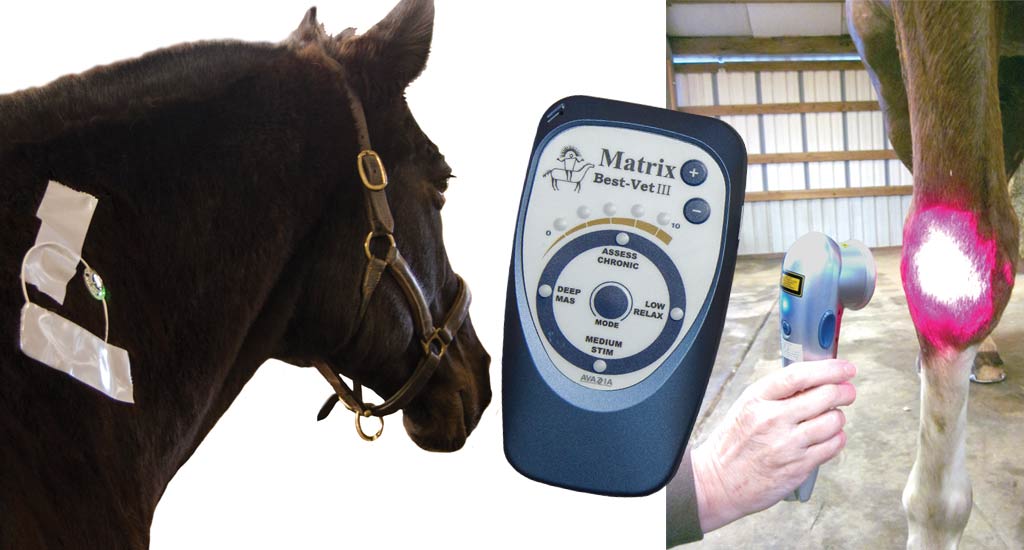A Brief Overview of Therapy Devices
A Brief Overview of Therapy Devices
Therapy’s primary goal should be to protect the body’s fascia. Fascia is a crucial component that makes up every structure of the body. When the fascia fails, a cascade of events leads to injury and dysfunction. Supporting the health of the fascia means recovery, comfort, and soundness within the body.
This list shares therapy device categories that benefit the body and help protect the fascia in contrast to other modalities that might be more for pain management and blocking pain. The contrasted therapy device categories mentioned can cause undesirable side effects, mainly when working with horses, other highly sensitive animals, and sensitive people.
TENS Family
Microamperes, or microcurrents, increase cellular energy to promote the healing of all tissues. Microcurrent is highly beneficial for tendon, ligament, nerve, bone, and muscle repair. Some devices with the always-on biofeedback feature find and release bound-up tissue, which occasionally causes visible spasms as the tissue releases.
Milliamperes temporarily block pain, and continuous use can damage nerve sheaths. This device has an output level 1000 times higher than microamperes, and it can be irritating and uncomfortable to animals. Devices that cause muscle contractions should be used carefully and judiciously. They are for forced contractions in muscle atrophy situations.
PEMF (Pulsed Electromagnet Field) Therapy
Low-dose PEMF (low dosages) can improve circulation, help with musculoskeletal issues, and reduce pain. The low dose is 200 gauss or less, averaging 50 gauss in Pub Med-listed studies. Low-dose PEMF reports have little effect on supporting the recovery of equine injuries.
High-dose PEMF devices that can cause muscles to contract or be felt visibly can cause tissue (fascia) to become rigid and drive tension to organs, causing pain, nausea, colic, headaches, and failure to thrive—the high-dose PEMF devices for horses packaged in rolling suitcases with rubber rings or horse blankets. When the devices are used, individuals nearby are potentially in harm’s way—considered pain-blocking devices by knowledgeable bodyworkers. FEI states nothing higher than 1,000 gauss is permissible, but what is this based on?
Sound Wave Therapies
Ultrasound: Ultrasound, or high-frequency sound waves, creates heat to improve circulation. This method can cause tissue to burn. Although improvements have been made in newer versions of ultrasound devices, they still pose a risk of burning tissue and can cause permanent damage. It is not worth the risk if better options are available.
Shockwave (ESWL -Extracorporeal Shock Wave Lithotripsy): High-pressure sound waves were initially designed to break up kidney stones in people. They were also found to be a pain blocker, so they became popular at backside race tracks. Shockwaves break up tissue and are very damaging to the fascia.
Infrasound (Low decibel sound waves): This therapy modality uses extra-low ranges that travel long distances and are entirely safe to the fascia. Its benefits include improving circulation, decreasing swelling, and reducing pain without the pain-blocking mechanism. Please note that this therapy modality should not be used on fractures.
Patches
The following are several patches offered with various types of therapy modalities.
Magnets, stickers, or anything applying a tiny amount of pressure will create a stimulus to acupoints.
MicroCurrent Patches: Effective and safe when used as directed.
PEMF (PSWT) as small patches and rings: Safe and effective in these low doses.
Electrolyte Patches and acupressure Patches: These come in various names, and when Googled, they do not seem to be backed by scientific research and do not provide any real benefit, therefore becoming simply a waste of money.
Light Therapy (LED and Laser)
Lasers: Lasers produce direct or focused beams of light. Lower-class lasers are safer choices and are therapeutic in improving circulation, particularly effective in skin conditions. Laser devices driven by high power, such as Class IV, can be dangerous to fascia, with adverse effects such as burning tissue. Class IV can even cause permanent damage to the tissue.
LED (light-emitting diodes): LEDs have dispersive light patterns easily absorbed by the skin. If a high-quality device is used, they are safe and effective.
Added features, such as increased diodes for coverage, wavelength spectrums, and additional frequencies, enhance the effectiveness of both lasers and LED devices. For example, a device with infrared and red with pulsed frequencies provides better treatment quality than a device with just red or infrared diodes.
Ceramic Textile Wraps
Lightweight, reflective, heat-trapping materials are safe when used in moderation to improve circulation. However, they can easily be misused, and if left on for too long, they can create a buildup of heat, for example, if left on a horse’s legs longer than recommended.
Contact Matrix for more information if you’d like help determining the right therapy tool for you and your situation.
______________________________________________________________________________
** The accumulation of this information is shared in good faith and will not necessarily agree with others. Thank the knowledgeable and experienced therapists who have shared their findings in experiences with various modalities that helped derive this list of general information. The continued research with all products means other attributes are being discovered. It is a responsible user that learns what those are and applies them appropriately.
Updated: 2024

